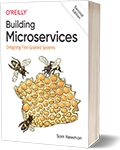Building Microservices: Designing Fine-Grained Systems Edition: 2
Software Development
Book Details
Book Title
Building Microservices: Designing Fine-Grained Systems Edition: 2
Author
Sam Newman
Publisher
O'Reilly Media City: Sebastopol, CA
Publication Date
2021
ISBN
9781492034025
Number of Pages
615
Language
English
Format
File Size
11MB
Subject
Software Architecture / Microservices
Table of Contents
- Copyright
- Table of Contents
- Preface
- PART I: Foundation
- Chapter 1: What Are Microservices?
- Microservices at a Glance
- Key Concepts of Microservices
- The Monolith
- Enabling Technology
- Advantages of Microservices
- Microservice Pain Points
- Should I Use Microservices?
- Summary
- Chapter 2: How to Model Microservices
- Introducing MusicCorp
- What Makes a Good Microservice Boundary?
- Types of Coupling
- Just Enough Domain-Driven Design
- The Case for Domain-Driven Design for Microservices
- Alternatives to Business Domain Boundaries
- Mixing Models and Exceptions
- Summary
- Chapter 3: Splitting the Monolith
- Have a Goal
- Incremental Migration
- The Monolith Is Rarely the Enemy
- What to Split First?
- Decomposition by Layer
- Useful Decompositional Patterns
- Data Decomposition Concerns
- Summary
- Chapter 4: Microservice Communication Styles
- From In-Process to Inter-Process
- Technology for Inter-Process Communication: So Many Choices
- Styles of Microservice Communication
- Pattern: Synchronous Blocking
- Pattern: Asynchronous Nonblocking
- Pattern: Communication Through Common Data
- Pattern: Request-Response Communication
- Pattern: Event-Driven Communication
- Proceed with Caution
- Summary
- PART II: Implementation
- Chapter 5: Implementing Microservice Communication
- Looking for the Ideal Technology
- Technology Choices
- Serialization Formats
- Schemas
- Handling Change Between Microservices
- Avoiding Breaking Changes
- Managing Breaking Changes
- DRY and the Perils of Code Reuse in a Microservice World
- Service Discovery
- Service Meshes and API Gateways
- Documenting Services
- Summary
- Chapter 6: Workflow
- Database Transactions
- Distributed Transactions—Two-Phase Commits
- Distributed Transactions—Just Say No
- Sagas
- Summary
- Chapter 7: Build
- A Brief Introduction to Continuous Integration
- Build Pipelines and Continuous Delivery
- Mapping Source Code and Builds to Microservices
- Summary
- Chapter 8: Deployment
- From Logical to Physical
- Principles of Microservice Deployment
- Deployment Options
- Which Deployment Option Is Right for You?
- Kubernetes and Container Orchestration
- Progressive Delivery
- Summary
- Chapter 9: Testing
- Types of Tests
- Test Scope
- Implementing Service Tests
- Implementing (Those Tricky) End-to-End Tests
- Should You Avoid End-to-End Tests?
- Developer Experience
- From Preproduction to In-Production Testing
- Cross-Functional Testing
- Summary
- Chapter 10: From Monitoring to Observability
- Disruption, Panic, and Confusion
- Single Microservice, Single Server
- Single Microservice, Multiple Servers
- Multiple Services, Multiple Servers
- Observability Versus Monitoring
- Building Blocks for Observability
- Standardization
- Selecting Tools
- The Expert in the Machine
- Getting Started
- Summary
- Chapter 11: Security
- Core Principles
- The Five Functions of Cybersecurity
- Foundations of Application Security
- Implicit Trust Versus Zero Trust
- Securing Data
- Authentication and Authorization
- Summary
- Chapter 12: Resiliency
- What Is Resiliency?
- Failure Is Everywhere
- How Much Is Too Much?
- Degrading Functionality
- Stability Patterns
- Spreading Your Risk
- CAP Theorem
- Chaos Engineering
- Blame
- Summary
- Chapter 13: Scaling
- The Four Axes of Scaling
- Combining Models
- Start Small
- Caching
- Autoscaling
- Starting Again
- Summary
- PART III: People
- Chapter 14: User Interfaces
- Toward Digital
- Ownership Models
- Toward Stream-Aligned Teams
- Pattern: Monolithic Frontend
- Pattern: Micro Frontends
- Pattern: Page-Based Decomposition
- Pattern: Widget-Based Decomposition
- Constraints
- Pattern: Central Aggregating Gateway
- Pattern: Backend for Frontend (BFF)
- GraphQL
- A Hybrid Approach
- Summary
- Chapter 15: Organizational Structures
- Loosely Coupled Organizations
- Conway’s Law
- Team Size
- Understanding Conway’s Law
- Small Teams, Large Organization
- On Autonomy
- Strong Versus Collective Ownership
- Enabling Teams
- Shared Microservices
- Internal Open Source
- Pluggable, Modular Microservices
- The Orphaned Service
- Case Study: realestate.com.au
- Geographical Distribution
- Conway’s Law in Reverse
- People
- Summary
- Chapter 16: The Evolutionary Architect
- What’s in a Name?
- What Is Software Architecture?
- Making Change Possible
- An Evolutionary Vision for the Architect
- Defining System Boundaries
- A Social Construct
- Habitability
- A Principled Approach
- Guiding an Evolutionary Architecture
- Architecture in a Stream-Aligned Organization
- Building a Team
- The Required Standard
- Governance and the Paved Road
- Technical Debt
- Exception Handling
- Summary
- Afterword: Bringing It All Together
- Bibliography
- Glossary
- Index
- About the Author
- Colophon
